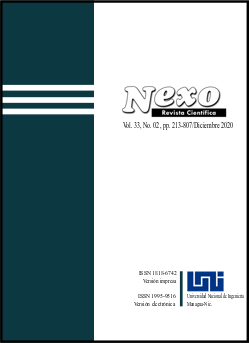Petrographic and isotopic studies in Kamoo area, northeast isfahan, Iran
DOI:
https://doi.org/10.5377/nexo.v33i02.10773Keywords:
Isfahan, Kamoo, Mineralogy, Alteration, SkarnAbstract
The study area is located 5.5 km north-east of Kamo County and 30 km north-east of Meymeh, Isfahan. Kamo Index comprises an anticline with a northwest-southeast trend, the outcrop of which consists of siltstone-sandstone and Jurassic shale rocks that lie along a cretaceous unit. Based on field studies as well as petrographic and geochemical investigations, mineral assemblages and minerals in the area include chalcopyrite, pyrite, marcasite, and magnetite as primary ores and malachite, bornite, covellite, chalcocite, hematite, goethite, and hydrous iron oxides as secondary ores. The secondary ores have been formed by oxidation and biogenic processes. The primary textures are granular, disseminated, vein-shaped, and layered and the secondary textures are boxed and martitized, shear zones, replacements, and veins. Tectonic, metamorphic, and oxidation factors are involved in the formation of these textures. Due to tectonic activity in this area and the presence of faults, replacement, vein, and shear textures, which have developed after mineralization, are observed. Among alterations, hematite, propylitic, sericitic, limonitic, and kaolinitic are highly prevalent and they are important in the formation of iron deposits. The sub-alkaline granitoids of the region are related to the continental subduction-zone orogenic series. Studies on the decomposed iron samples from Kamo show that most of the samples are in the sub-alkaline series and the chemical and mineralogical composition of the magma derived from this series is calc-alkaline with a large amount of iron. According to mineralogical, lithological, and geochemical evidence and based on isotopic results, Kamo deposit is a skarn-type deposit.
Downloads
Downloads
Published
How to Cite
Issue
Section
License
Copyright (c) 2021 Array

This work is licensed under a Creative Commons Attribution 4.0 International License.
The authors who publish in Nexo Scientific Journal agree to the following terms:
- Authors retain the copyright and grant the journal the right of the first publication under the license Creative Commons Attribution License https://creativecommons.org/licenses/by/3.0/, which allows others to share the work with a recognition of the authorship of the work and the initial publication in Nexo Scientific Journal.
- Authors may separately establish additional agreements for the non-exclusive distribution of the version of the work published in the journal (for example, in an institutional repository or a book), with the recognition of the initial publication in Nexo Scientific Journal.
- Authors are allowed and encouraged to disseminate their works electronically (for example, in institutional repositories or in their own website) before and during the submission process, as it can lead to productive exchanges, as well as earlier and greater citation of published works.











